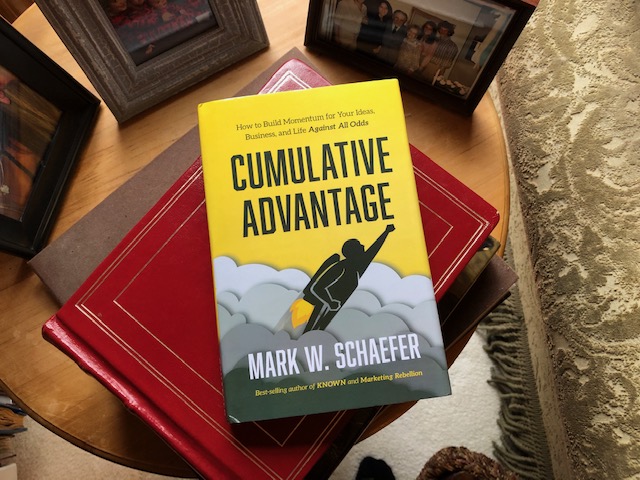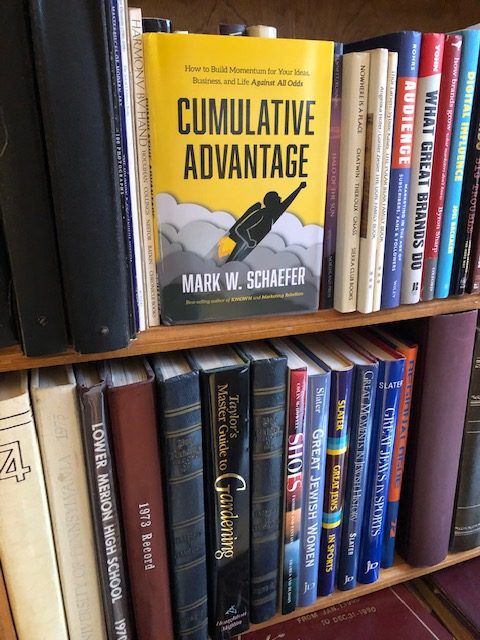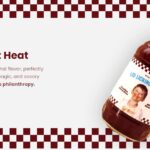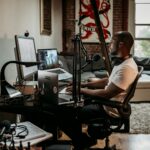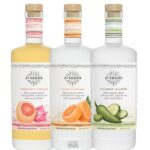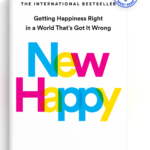Tim Ferriss knows Oprah. Mark Schaefer does not.
What Cumulative Advantage did Tim have, if any? This question sparked my friend Mark to start percolating ideas for his new book called Cumulative Advantage.
Tim Ferriss is best known for is his concept of and the book about the 4-hour workweek. “The 4-Hour Workweek” allows for travel and living more while working less. Tim has a wildly successful, award-winning podcast and one of the most in-demand speakers.
But why did Tim become Tim?
How did he gain so much success and access to people like Oprah? In fact, he is often called the “Oprah” of audio. What can we learn from his experience as a phenomenally successful entrepreneur who didn’t have any unique advantage?
Mark’s new book called Cumulative Advantage tries to unravel the mystery of building momentum. Mark Schaefer is a marketing author, teacher, and friend, and is one of the top marketing thought-leaders who often ask the most provocative questions.
The Mathews Effect
As Mark was thinking about momentum and advantage, he stumbled upon a 1960’s research topic by Robert Merton. Merton wrote about The Mathew Effect.
The Matthew effect of accumulated advantage, Matthew principle, or Matthew effect for short, is sometimes summarized by the adage “the rich get richer, and the poor get poorer.” The concept applies to matters of fame or status but may also be used literally to cumulative Advantage of economic capital.
The Mathews Effect derives its name from a verse in the New Testament (Matthew 25:29) which reads, “For unto every one that hath shall be given, and he shall have abundance: but from him, that hath not shall be taken away even that which he hath.”
Merton, who was a Jewish Immigrant who lived in South Philly, grew up with nothing.
His father’s milk delivery burned down; Merton had to quit school. He didn’t have any advantage in life. As a young boy, he would walk to the Carnegie library because he had issues getting into a school. Merton became self-taught.
The librarians adopted him, and he eventually, against all odds, got a scholarship to Temple University and went on to Harvard for a Ph.D. He then taught at Columbia University in NYC.
Merton wondered why the rich get richer, and the poor get poorer. Like his experience and personal story, he wanted to understand why this was true.
He studied Nobel prize winners – once you get an initial advantage, it grows and grows. The research part that tantalized Mark was the disparity – the haves and had nots. Merton talked about this idea and said that nothing could stop this from occurring unless there are countervailing processes.
But Merton never identified the countervailing processes.
So, this became Mark’s passion for understanding what those countervailing processes might be.
Merton’s son won a Nobel Prize in economics – teaches at MIT, and Mark needed an answer about the countervailing process. After reaching out to Merton’s son, he suggested Mark speak with Merton’s wife, who still teaches at Columbia.
She told Mark that they never addressed it to real lives – more of a theory. Their work was more academic but never tried to figure out the practical way that someone could countervail this theory of the rich getting richer and the poor getting poorer.
Unlocking the Code
Mark wondered, what do you do if you aren’t born with privileged in life?
In Mark’s book Cumulative Advantage, he illustrates five key threads that weave together a bridge to countervailing how to gain momentum and break away from a lack of advantage.
To arrive at these insights, Mark conducted some original research to learn about people with no cumulative advantage who became successful. It turns out five things were similarly rated by all the entrepreneurs in his study. The good news is that there is a hopeful theme that emerged because all these five ideas are accessible to anyone.
- INITIAL ADVANTAGE: – Bill Gates was one of the only teenagers with access to computers as a child, so he learned to code early. This little advantage made him aware of a door that was open right in front of him. He had something others didn’t know that came from access and persistent curiosity. If you read Outliers by Malcolm Gladwell, he also blows apart the ‘rags to riches’ idea. Hidden advantages can appear modest and small – like a persistent parent’s encouragement. Entrepreneurs take advantage of subtle benefits and exploit and leverage them for success.
- THE SEAM: – In his famous book Competitive Advantage, Michael Porter wrote the blueprint for strategy in the ’90s. Then in 2002, Porter’s company went bankrupt? How is that possible? Strategy today is different than it was just twenty years ago. Today we must test ideas today uses speed and agility to learn from the market. Schaefer uses the example that football coaches will look down on a field to find the seam, like seeing a player’s slight weakness. Coaches then try to exploit that small advantage by identifying even minor flaws in an opposing team. Strategy today is what we can do quickly to bust through that seam. Business strategy or life strategy isn’t about a fifty-page plan. It is about taking advantage of speed, urgency, and immediacy to test if a seam can be ripped open to expose a more significant opportunity.
- AWARENESS: – Mark calls this third idea the sonic boom – how ideas move in our world is different than we think. We can do many things to spread our ideas. But Mark’s insight is that t if you can focus on the next two weeks – not six months, you can create a big splash of attention- a sonic boom. It makes a blast of awareness. It gives you a short period of intense awareness versus spreading it out over time. It reminds me of how I use to buy broadcast advertising in the 1990s for the Slim Jim brand, where for the first two weeks of an eight-week advertising campaign, we would have four times the exposure so our target wouldn’t miss our message.
- REACHING OUT AND UP: – mentoring has always been about building a long-term relationship. Mark’s view is more about learning quickly and in the short term – the real need is the opportunity, connections, and opening doors. Can you reach out and up to someone above you or part of a community to access people, resources, and insights of value. Mentors today can give you this leg up – help you scaffold toward people who can help you get your idea in motion.
- CONSTANCY OF PURPOSE: You can’t ever forget what got you where you are. Jim Collins talks about the doom loop; when things are going bad, you forget why you are there. This happens in every process. If you can execute with discipline, structure, and the right people to maintain the momentum, being persistent in your focus is a powerful tool to drive rate.
Mark’s Books
There are themes from Mark’s other books in Cumulative Advantage like his work in The Marketing Rebellion, Return on Influence, and KNOWN, Check out his books here.
When you bundle together Mark’s work, you see the trajectory of one core idea – how can we be heard? What is the secret to being seen and noticed?
R.I.T.E.S.
Attention and being heard is getting harder and harder. It used to be that Mark promoted an idea he called RITE. Content must be Relevant, Interesting, Timely, and Entertaining. But today – he calls it RITES – because it also needs to be Superior.
It isn’t enough to be great. It would be best if you were the best in your niche or people abandon you. Think of how much great content on TV or streaming – how do you get recognized? One of the answers is through momentum. According to Mark, ideas don’t sell themselves – it’s an illusion. If you are so in love with your vision, you’ll kill the momentum.
So Why Does Tim Ferris Know Oprah?
Like all of Mark’s work, Cumulative Advantage is well-written, fun to reach, and filled with rich, specific examples. I read the book over a weekend.
I’d urge you to buy a copy from your local bookseller or at Amazon. Reading Mark’s new book may give you a cumulative advantage to build momentum in your business and life. Even against all odds.
At the end of Mark’s book, he reveals why Tim knows Oprah and Mark doesn’t. He ties together what he learned through his research with some keen observations. He shares some crucial differences between how Tim and Mark brought their work into the public domain and how Tim did some things intentionally different. I’m not going to spoil the answer – you’ll need to buy the book. And it is worth the price to learn how momentum is a decisive advantage when harnessed.
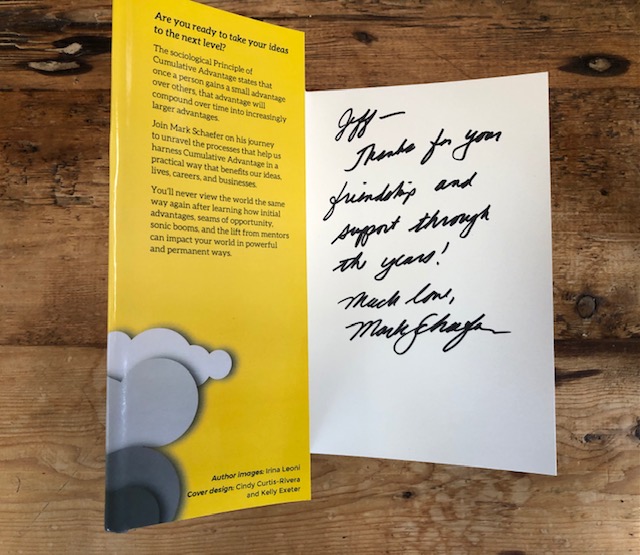
By the way – I have a cumulative advantage.
I don’t know Oprah or Tim – but I do know Mark.
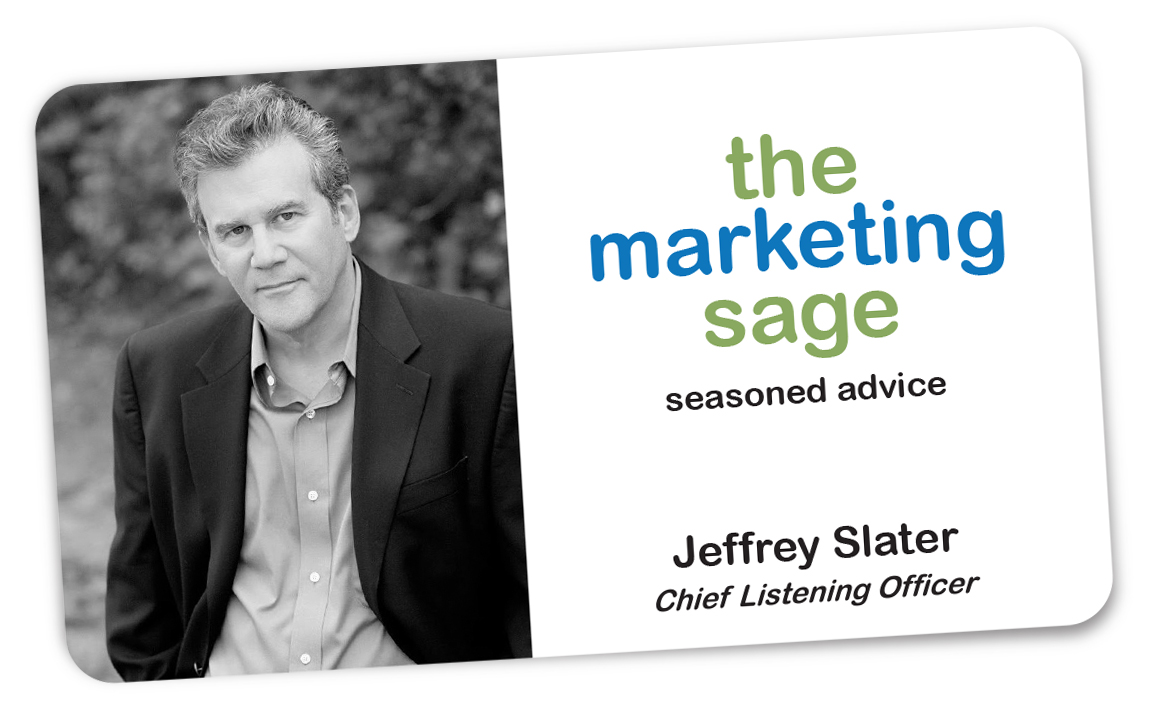
Need help with your marketing?
I can help. You can set up a time to chat with me about your marketing challenges using my calendar. Email me jeffslater@themarketingsage.com Call me. 919 720 0995. The conversation is free, and we can explore if working together makes sense. Watch a short video about working with me.
